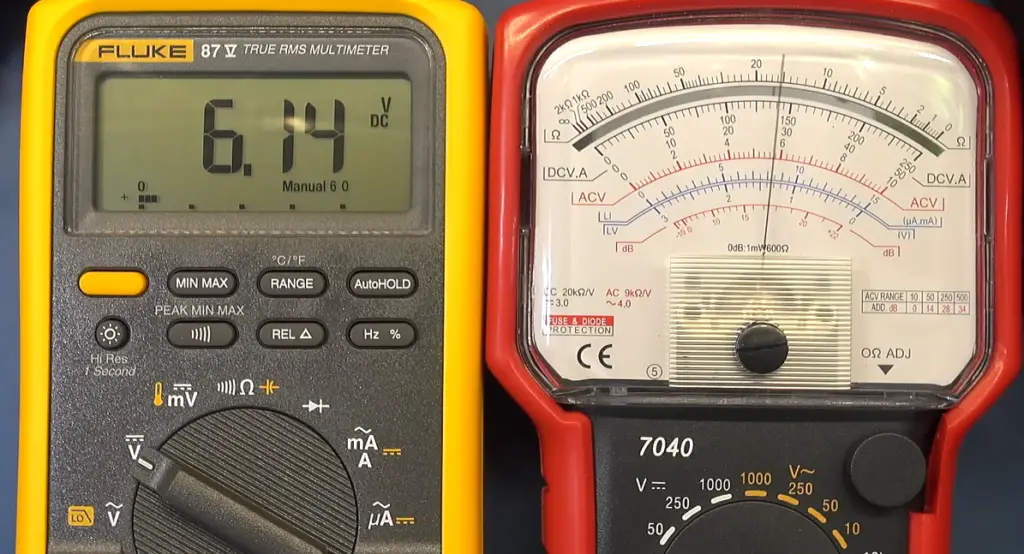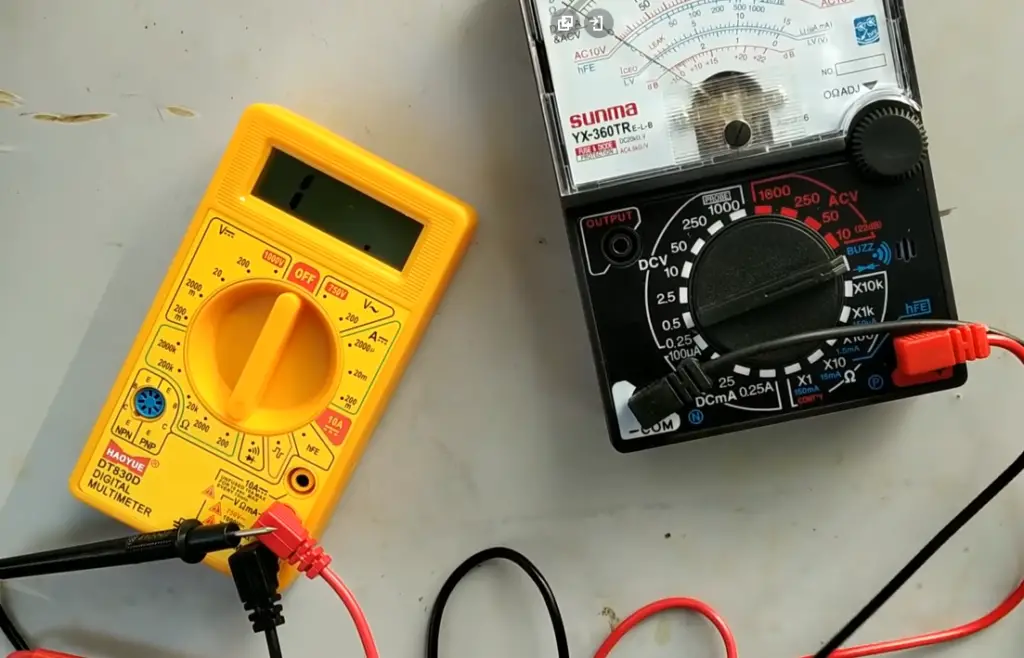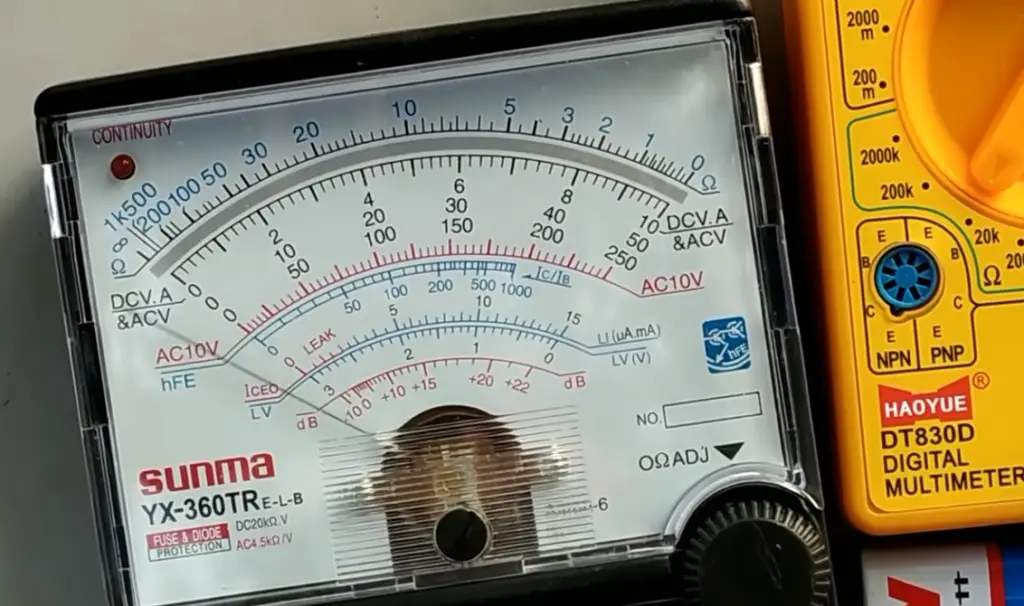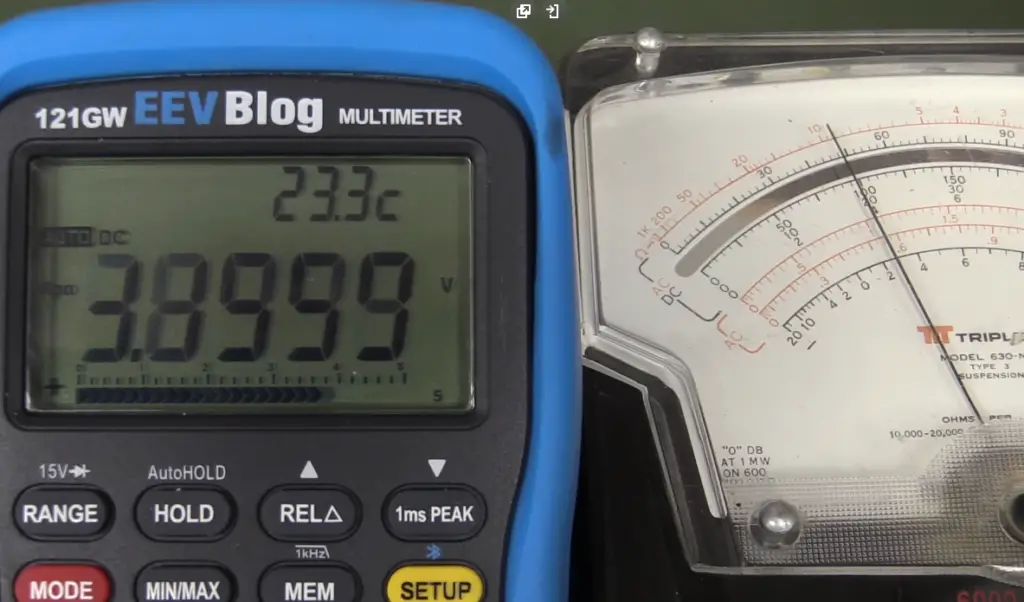When it comes to measuring electrical values, multimeters are a crucial tool. But did you know that there are two types of multimeters: analog and digital? So what’s the difference between the two?
Analog multimeters use a needle and printed scales to display measurements. Digital multimeters, on the other hand, display measurements through numbers on a screen.
Multimeters are essential tools for electricians and hobbyists alike.
There are two types of multimeters: analog and digital. So, which one is better? In this blog post, we will discuss the differences between analog and digital multimeters and help you decide which one is right for you!
What Is An Analog Multimeter?
These devices are excellent for reading voltage, current, resistance, frequency, and signal power. A switched-range analog multimeter can be very affordable, however, they can be a bit difficult to use. Users who are new to multimeters may have trouble reading the resistance scale. To make measurements on a scale calibration an analog multimeter moves a needle along the scale. The analog multimeter also exhibits low resistance and high sensitivity with scales down, which can make it difficult to use.
The advantage of using an analog multimeter is when checking a diode the analog is usually more accurate. Other than that, many professionals choose to use a digital multimeter [1].

What Is A Digital Multimeter?
As mentioned above, the main difference between digital and analog is the display. The digital multimeter displays the reading in digits most times on a LED or LCD screen. This makes taking measurements much more accurate. The digital meter can measure voltage better because of its higher resistance of 1 M or 10 M. On top of that, an auto-ranging feature really helps electronic hobbyists, because sometimes the measurement range is unknown [2].
Multimeter Uses
These types of instruments are widely used in:
- electrical circuit lab for testing circuits;
- troubleshooting a communication circuit;
- electrical project lab;
- maintaining and performing many kinds of tasks in outdoor fields like a substation;
These are the basic applications in daily life. Most linemen or technicians already know the importance and benefits of having a multimeter tool [3].
Difference Between Analog And Digital Multimeter
Display
Analog multimeter uses a printed, continuous scale. A needle moves along the scale to indicate a reading. A digital multimeter uses a digital display. The biggest difference between an analog and digital multimeter is the screen display. The analog multimeter has a needle and gauge system to display measurements. The digital multimeter displays measurements on a numeric LCD screen.

Response Time
Digital multimeters are able to display readings much faster than analog multimeters.
Ease of Use
Many users find digital multimeters easier to read and use compared to analog ones.
However, some argue that familiarity with an analog multimeter allows for quicker troubleshooting.
Ultimately, it comes down to personal preference and experience.
Operating Mechanism
An analog multimeter uses a galvanometer that primarily measures current. Digital multimeter measures voltage using an analog-to-digital converter.
Sources Of Error
Taking readings from an analog multimeter may produce parallax errors. With a digital multimeter, it is difficult to determine an accurate average value when the reading is fluctuating.
Analog multimeters also have limited resolution, meaning they can only display certain increments in measurement. Digital multimeters, on the other hand, can display a much greater range of values with higher accuracy and precision.
Additionally, digital multimeters offer many more functionalities such as data storage and automatic ranging. This allows for easier data management and analysis.
Calibration
Analog multimeters need to be calibrated often. Digital multimeters may also require calibration. However, they do not need to be calibrated as often as analog ones. Overall, digital multimeters offer greater accuracy and functionality. However, analog multimeters may still be the preferred choice for certain applications due to their simplicity and lower cost. Ultimately, it is important to consider the specific purpose and requirements of your measurement before choosing between an analog or digital multimeter.

Representation Of Measuring Signal
The analog instrument shows a continuous signal. The digital instrument shows the discrete signal [4]. Also, the analog multimeter has a needle that moves along a scale to indicate the measurement, while the digital multimeter displays the measurement as numbers on a screen.
Size Of Multimeters
The analog multimeter occurs in a large size as compared to the digital multimeter. The digital multimeter occurs in a small or pocket size. And it can easily fit in your pocket.
Measurement
In the case of measurement, it gives less accuracy. It gives more accuracy as compared to the analog multimeter.
Cost
Analog multimeters can easily get at a low cost. Digital multimeters are very costly.
Output Readability
It indicates the approximate or less accurate reading due to the pointer moving over the calibration scale. It indicates accurate reading due to the numerical value.
Nature Of The Signal In Multimeter
The moving pointer or needle gives a continuous movement in order of magnitude for momently changes of the signal. This does not give a continuous movement in order of magnitude.
Polarity
In an analog multimeter, the positive and negative polarities are represented by using the right and left sides of pointer deflection respectively. In a digital multimeter, the positive and negative polarities are represented by using the positive and negative signs respectively.

Sensitivity
Analog multimeter has more sensitivity. Digital multimeters have less sensitivity. This means that an analog multimeter can measure smaller changes in voltage and current, while a digital multimeter may not be able to accurately measure those small changes.
Speed Of Operation
The analog multimeter has a lower speed. The digital multimeter has a higher speed. This means the digital multimeter can give you readings quicker and more accurately.
What To Choose: Analog Or Digital Multimeter
The Feature Gap Narrows
Multimeters, from small handheld to more sophisticated benchtop models, are indispensable tools for testing electrical voltage, current, and resistance, depending on the model, frequency, and signal power. Some believe analog meters are inferior to digital ones, but that’s not the case in many real-world applications. So, dismissing analog out of hand would be a mistake.
Both types of meters have their pros and cons, but the feature gap is narrowing. The ubiquity of integrated circuits in all things electronic has led to a flood of lower-cost digital models. However, there are still times when a digital, analog, or hybrid analog/digital meter can be the right choice for the job.
Analog units, for instance, commonly rely on an electro-dynamometer to measure both ac and dc.
Digital units utilize components such as resistors and diodes to convert signals to a value that an analog-to-digital converter (ADC) can use to show the measured signal value:
- The 260-8Xi analog volt/ohmmeter (VOM) has many similar aspects to its digital cousin;
- The 467E digital multimeter (DMM) has multiple voltage ranges in both ac and dc as well as multiple current ranges;
Feature-wise, digital meters generally offer greater speed. Digital meters also eliminate interpolation errors; have no moving parts to break; and provide “auto-ranging” to prevent errors and damage to the meter if the user selects the wrong range (this feature can be done on analog units but is more complicated). They also can test continuity; capacitors, diodes, and transistors; and frequency, as well as record and export data for various test and measurement functions.

Digital meters also have a few drawbacks, starting with their need for an external power source for all measurements. Typically, that means batteries, which cause LCD displays to dim as they lose charge. Moreover, they can record errors due to fluctuations, transients, and even extended use if the unit gets too warm.
While analog meters may not offer apples-to-apples parity in terms of accuracy for small, portable units, advanced desk/benchtop analog units can provide accuracy on par with digital meters. Analog meters require no power source for current and voltage measurement (but do for measuring resistance). Analog meters also are less susceptible to electric noise; have a broader voltage range, and are suited to adjusting tuning circuits or peaking tunable responses – which isn’t the case with digital meters.
Practical Analog: Ideal In The Field
Hybrids aside, there are practical uses for traditional analog meters, especially in the field as opposed to laboratory uses. Applications range from commercial to industrial uses, particularly in the field in isolated conditions. Examples include monitoring minute value changes in automotive, as well as maintenance of geographically isolated assets in applications ranging from submersible well, and pumps to agriculture to marine/ship industry applications.
In the field, such electrical investigations often involve hands-on observations in real time. In these cases, “old-school” analog technology can be the most practical and productive option. For example, because analog units don’t require power for many uses, a technician in the field can be more productive with analog by simply monitoring the current through a wire, instead of having to “break open” the component being measured as with a digital meter.
Other applications that may “move the needle” toward an analog meter include rate-of-change observations. For example, if a measurement cycles from 0 to 9 amps, it’s easier to read a needle than the blur of rapidly changing values on a digital display.
In a related use, some analog units provide a zero-center function that places the needle in the middle of the scale. It’s easily viewed as it moves left or right, as opposed to having to view separate, simultaneously positive and negative values that are displayed in separate digital readouts.
Hybrids For “Best Of Both” Benefits
Analog and digital features are complementary, and in certain cases work well together—even in the same unit with hybrid analog-digital meters. Since the early 1980s, meters have been offered with both analog and digital features. Today’s hybrid analog/digital models further narrow the feature gap with traditionally digital features such as auto-ranging, data export, and other features that may offer a best-of-both-worlds solution.
The real choice depends on the application. Prices, like functions, can vary from lower cost to laboratory models that go for thousands of dollars. Somewhere in the middle are meters for field use.
From inexpensive handhelds to thousands of dollars for calibrated, certified test-and-measurement laboratory models, choices abound for all uses [5].
Digital multimeters measure more accurately than analog multimeters.
For measurements of different magnitudes in both analog and digital multimeters, the measuring range is selected by turning the selection knob. For example, to measure 12V DC voltage, the selection button should be set to 20V DC, which is an upper voltage range, and 600V AC to measure 380V AC voltage. Many modern digital multimeters have an auto-range feature.

In the case of reverse polarity in analog multimeters, the pointer tries to deviate to the left. This may damage the multimeter. Digital multimeters can show negative (minus) values.
The analog multimeter does not need a battery for current and voltage measurement. The battery is only required for resistance measurement. A digital multimeter requires a battery for all measurements.
Analog multimeters can be calibrated manually. Digital multimeters require automatic calibration.
Analog and digital multimeters are mostly small and portable. There are also advanced desk-type multimeters that can measure up to a very high degree of accuracy. Multimeters are used to detect electrical problems in a wide variety of applications such as electrical appliances, power supplies, motor controls, and wiring systems [6].
FAQ
Are cheap multimeters any good?
It depends on what your needs are. Generally, cheaper multimeters may not be as accurate or reliable for measuring precise values. However, for basic measurements or occasional use, a cheap multimeter may suffice.
What is the key difference between an analog and a digital multimeter?
An analog multimeter uses a needle and gauge to display measurements, while a digital multimeter displays measurements in numeric form. Digital multimeters tend to be more precise and have more features, but analog multimeters can still be useful in certain situations such as measuring fluctuating or changing values.
It ultimately depends on your specific needs and preferences. Some people prefer the simplicity and ease of reading measurements with a digital multimeter, while others may prefer the visual representation provided by an analog multimeter.
Can a multimeter measure voltage, current, and resistance?
Yes, a multimeter is capable of measuring all three of these values. However, it is important to make sure that the multimeter is properly equipped and set to the correct measurement function before taking any readings. Failure to do so can result in inaccurate measurements or even damage to the device.
Do analog multimeters require batteries?
The analog multimeter doesn’t use a battery, except for the ohms function. A dead battery makes the DMM totally inoperative. Noisy signals are easier to read with an analog meter [7].
What is better than a multimeter?
It ultimately depends on what you are measuring and your specific needs. For example, a thermometer would be better for measuring temperature, while an ammeter would be more useful for measuring electrical current. However, a multimeter can often serve as a versatile tool for various types of measurements. In some cases, specialized equipment may provide more precise or accurate readings than a multimeter.
Why are analog multimeters inaccurate?
Analog multimeters may not be as precise as digital multimeters, and they can also be prone to human error in reading the gauge and needle placement. However, they can still be useful for rough estimates or measurements of changing values. It is important to calibrate an analog multimeter regularly to ensure accuracy.
How do you read an analog multimeter?
Reading an analog multimeter is different from a digital one. In analog multimeters, the result is shown through a needle pointing on scales. Typically they come with three scales that are for separate parameters that’s why new people may get confused.
The first and lower scale is for DB (decibels) value, AC is for AC voltage, DC is for DC voltage reading, Ω is for resistance measurement. Some analog multimeters also have additional functions like capacitance, micro amps, and milliamps current measurements. These are denoted by their signs on the right side of the scale respectively [8].
How much should I spend on a multimeter?
Most multimeters on the market today are digital, and they’re a bit pricier, ranging from $20 to $500, or even more, based on quality and precision [9].
What brand of multimeter is best?
There is no definitive answer as it ultimately depends on individual preferences and needs. Some popular brands include Fluke, Klein Tools, and Extech. It is important to do research and read reviews to determine which brand may be the best fit for your specific requirements. Ultimately, investing in a high-quality and reliable multimeter can save time and ensure accurate measurements.
Can you hear the difference between digital and analog multimeters?
No, a multimeter measures electrical values, not sound. A device designed for audio measurements, such as an oscilloscope or spectrum analyzer, may be able to detect differences in sound between digital and analog signals. Additionally, the human ear may not be able to detect subtle variations in sound quality between digital and analog signals [10].
How do you connect a digital multimeter to a circuit?
First, make sure that the multimeter is set to the correct measurement function. Then, connect the appropriate probes to the desired points in the circuit and take readings as necessary. Always consult the manual for proper usage instructions and safety precautions. It is important to disconnect power from a circuit before taking any measurements to avoid potential damage or harm. Additionally, always use caution when handling electrical equipment and never touch live wires.
What is the most common type of multimeter used?
Digital multimeters are the most commonly used type, as they tend to be more precise and efficient. However, analog multimeters may still have their uses in certain situations. Ultimately, it depends on individual preferences and needs. It is important to consider factors such as accuracy, versatility, ease of use, and durability when choosing a multimeter.
What does a reading of 0 ohms mean?
Resistance, symbolized by the (Ω) symbol and measured in Ohms, is a measurement of how well a current can travel through a circuit or a given path. A circuit with no resistance (0) would indicate a complete circuit or one that has no short [11].
How do you calibrate an analog multimeter?
An analog multimeter can be calibrated by adjusting the zero adjustment screw or knob on the meter face until the needle rests at zero when there is no current traveling through the circuit. This process should also be completed for each range of measurement that will be used on the multimeter to ensure accurate readings.
What are some limitations of a digital multimeter?
One limitation of digital multimeters is their inability to accurately measure very high frequencies or very low resistance, as these require specialized equipment. Digital multimeters may also have limited resolution in certain ranges, meaning they may not display all digits of reading accurately. Finally, digital multimeters may not be able to handle as much voltage or current as an analog device.
What does OL mean on a multimeter?
This is a common misunderstanding but OL means open line. It means that what is being measured is not making its way from the black probe to the red probe. You will always see this in diode mode, ohm mode, and continuity mode when the probes are not touching each other / not connected [12].
What type of multimeter do most electricians use?
There is not a consensus on the type of multimeter that most electricians use, as it may depend on personal preference and the specific tasks they are completing. Some electricians prefer analog multimeters for their ease of use and familiarity, while others prefer digital multimeters for their increased accuracy and ability to store readings. Overall, the important factor is choosing a reliable and accurate device.
Why do older analog multimeters damage computers?
You should only use a DMM (digital multimeter) instead of the older needle-type multimeter because the older meters work by injecting 9V into the circuit when measuring resistance, which damages most computer circuits.
Useful Video: EEVblog #1067 – Analog vs Digital Multimeters!
References
- https://www.circuitspecialists.com/blog/analog-or-digital-multimeter/
- https://pediaa.com/difference-between-analog-and-digital-multimeter/
- https://dipslab.com/difference-analog-digital-multimeter/
- https://dipslab.com/difference-analog-digital-multimeter/
- https://www.electronicdesign.com/technologies/test-measurement/article/21215098/simpson-electric-company-whats-the-difference-between-analog-and-digital-multimeters
- https://www.aydinlatma.org/en/what-is-the-difference-between-analog-and-digital-multimeter.html
- https://www.weschler.com/blog/advantages-of-an-analog-multimeter
- https://meterreviews.com/how-to-read-a-multimeter/
- https://www.bobvila.com/articles/best-multimeter/
- https://www.tester.co.uk/blog/electrical/digital-and-analogue-multimeters-which-is-better/
- https://www.rightchannelradios.com/blogs/troubleshooting-guides/18428251-resistance-and-multimeter-use
- https://learn.sparkfun.com/tutorials/how-to-use-a-multimeter/measuring-resistance














Leave a Reply